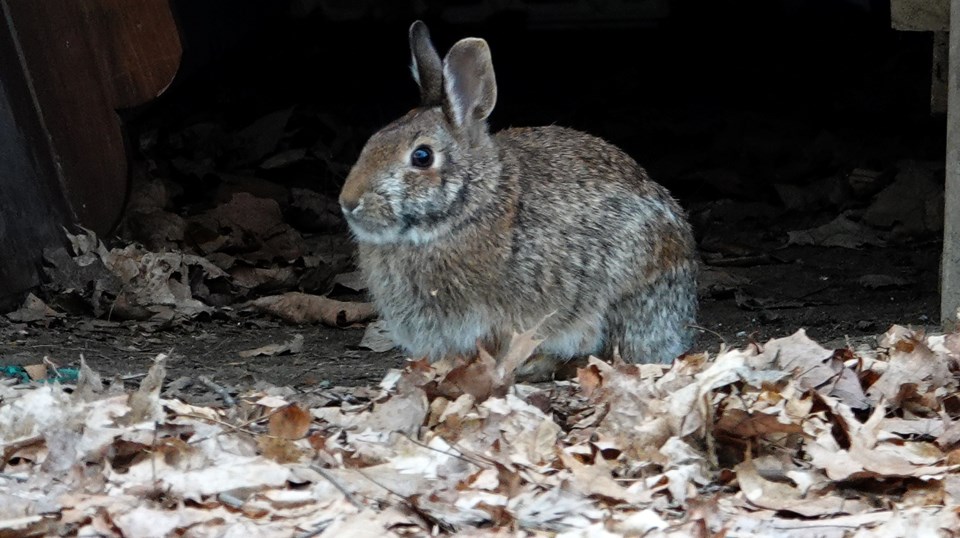A number of years ago we inherited a ceramic rabbit, the kind that is placed in your garden to add some ambience of wildness to the place. After being moved around on an annual basis, one of the ears was broken off. It began to look like a piece of garden debris and was relegated to a leaf-filled corner of the garden fence.
Now that you know this bit of background, you will no doubt share in my surprise as I looked out the window this morning and noticed that somebody had not only moved it, but had repaired the ear as well! And, now get this, had also installed a radio-controlled motion to it, as it was now facing the opposite direction as when first observed.
As I turned and congratulated Julie on this masterful re-use of an old piece of garden junk, she mumbled something about “look again, dear, I think it’s a real rabbit.” Her intuitive insights astound me daily.
Indeed, from time to time over the winter months a set of cottontail rabbit tracks had appeared in the snow, usually around the bird feeders. So without the snow to indicate its tracks, you no doubt further understand my confusion of seeing this creature without the benefit of tracks for identification.
A snowshoe hare had also been silently passing through on moonlit winter nights, but its footprint was almost twice the size of the smaller cottontail.
Although snowshoe hares turn brown in spring (by shedding their thick winter coat of white hairs) it seems early for this transformation to have occurred; they are caught in this early melt by still having a white body against a brown forest floor. Great fun if you are a great horned owl!
Biologically, hares and rabbits are the same but different. Both have a unique set of double upper front teeth (but only one pair are used; the second pair just sit there behind the big front teeth). However, after that dentally-shared trait, they are quite different in their behaviours.
The cottontail rabbit digs a burrow or uses an old groundhog hole to give birth to several naked and blind babies (this is called altricial). The hares just scrape a level spot in the leaves and gives birth to young ones that are fully furred and have their eyes open (this is called precotial).
Both the cottontail and the snowshoe are considered natural species, in that they gradually moved into this area as the glacier melted and the grasses grew. Some researchers feel that the cottontails were a distant second to arrive, moving in after human settlement occurred and farm fields were created.
For a while we had a third species hopping about the landscape, that one being the European hare or “jackrabbit.” This foreign species was deliberately brought to Ontario from Germany in 1912, to a place called the Bow Park Farm, near Brantford Ontario. The owner/operator was a chap named Otto Herold.
Apparently Otto ordered and received seven female and two male European hare for his farm, having them shipped directly from Europe. It is not known if these were domestic critters or wild caught, nor is it confirmed if they were brought here for potential commercial meat production or for the intent to release them to the wild.
Long story shortened, they “got out” and within a few years these giant hares were being noticed all around the Brantford area. And I do mean giant, as these animals were easily twice the size of a snowshoe hare! They loved the open countryside so characteristic of south-central Ontario, and prospered quickly.
The cottontail claimed the garden shrubs, the snowshoe hare dominated the conifer swamps, and without competition the European hares swarmed the open countryside.
Some of the local farmers were not at all happy with these crop-munching critters taking over their fields, and encouraged hunters to have a go at keeping their numbers down. Thus, from about 1920 through to 1960, jackrabbit hunting was an active sport in southern Ontario.
A good-sized ‘jack’ could weight 12 to 15 pounds, so a lot of meat was provided, especially appreciated during the 1930s depression years. Being about the size of a fawn deer, these hares were unmistakable as they blazed around open fields at speeds up to 75 km/h! (Yes, I know, I just mixed Imperial and metric in the same statement… live with it.)
Personally, I have seen only one and that was back in 1984, in a field in Oro-Medonte Township. As these hares were not fully acclimatized to winter, my observation was a fairly northern sighting. But by that same time, the population of European hare was dropping drastically across Ontario.
Perhaps the habitat was changing (mega-sized fields of corn or soy instead of hay crops), or perhaps the hunting pressure (which was intense for a couple decades) finally tipped the scales? And the sprawl of human habitations certainly has pushed away many field animals.
Today there are rare reports of someone seeing a ‘jack’ but these are viewed with suspicion that the animals seen were just big snowshoe hares. I have no doubt there are a few European hare still out there, but perhaps like Bigfoot they are disappearing into myth.
Maybe I should get a ceramic replica made of a European hare, and leave it in various places around our farm ... maybe luring in a real one.



